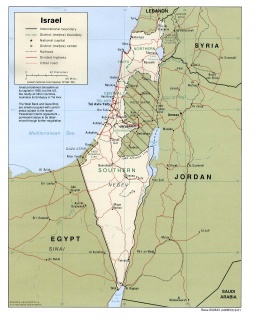Anonymous Declares War on Israel
As Gaza Strip Conflict Between Hamas and Israel Winds Down, Cyber Attacks on Jewish State Build

With thousands of rockets flying between both Israeli Defense Forces and Hamas fighters in the Gaza Strip this week, we are seeing a new form of warfare express itself online. According to a press release by the activist group Anonymous, it has declared a cyber war against Israeli officials dubbed #OpIsrael.
“November 2012 will be a month to remember for the Israeli defense forces and Internet security forces,” said the press release. “Israeli Gov, this is your cyberwar.” The group proceeded to publish personal documents and information on over 5,000 Israeli government officials in what was apparently the first volley of what could end up being a cyber campaign of epic proportions.
As I write this, the Twitter and Facebook accounts of the deputy prime minister of Israel have just been attacked, and the PM has yet to regain control of either account. His twitter account @silvanshalom, now reads: “WE THE PEOPLE WANT LASTING PEACE, PALESTINE TO BE RECOGNIZED BE FREE. END THE OCCUPATION. STOP THE ATTACKS #FREEPALESTINE #GAZA”
While the excessive use of capitalization shows that the hackers want their message heard, many of the latest cyber attacks have not been so benign. In one such attack, the Israeli Foreign Ministry’s international development program, known as Mashav, had its databases deleted in what could be a crippling attack. As well, the official website of the Israeli PM and the official blog of the Israeli Defense Forces were defaced and taken down for a period of time. They are currently both back online. Most recently, personal information on 35,000 Israeli officials was published online alongside a profound question from Anonymous that reads: “Every government can start a war, but can they ensure peace? “
Not all of the cyber action related to the Israel-Hamas fighting has been combative in nature. The activist group Telecomix — which has self-styled itself as the antidote to the destructive nature of Anonymous — embarked on another bold effort to monitor, aggregate information, and provide communication assistance to those in need. A few days ago, it launched a website called voxpalestine.org that has been aggregating tweets and live-streams from inside the Gaza Strip in real time. Through those streams, any concerned citizen could view the destruction and sounds of the military campaign against Hamas as it occurred.
And with the help of free, old-school dialup Internet access numbers and SMS text messaging networks, Telecomix is also providing a communication infrastructure that activists on the ground in Gaza are using to relay information to the world via Twitter. Many of these techniques were developed and fine-tuned during the Arab Spring movement, which is when Telecomix sprung into action to provide the same advice to activists in Egypt, Tunisia, Libya, and Bahrain during their own respective popular revolutions. Similar efforts continue to be employed during the ongoing Syrian conflict, during which Telecomix agents have successfully brought underground communication networks online and smuggled videos from the frontline out of the country, helping create a permanent record of human rights abuses that continues to this day.
Regardless of how effective these cyber attacks or digital aid packages are, they’re likely to be of little use to the innocent civilians currently caught in the crossfire of this longstanding conflict. On Tuesday, leaflets were dropped into the Gaza Strip by the IDF urging citizens to flee their homes. But in one of the most densely populated corners of the world whose borders are sealed, it’s hard to imagine where the 1.7 million people who live there would go. As of the latest available information, 138 Palestinians and five Israelis have been killed since Wednesday, according to Al-Jazeera English. According to AFP, more than 920 individuals have been injured on both sides so far and the number is likely to increase if hostilities start again.
It also appears that the Gaza-covering media may have been a target during some of this campaign. Two buildings that housed multiple Western news outlets, such as CNN, Reuters, and the Associated Press, were targeted, injuring seven journalists, and the offices of Al-Jazeera and AFP were also hit by multiple rockets on Wednesday, though no one was injured. More tragically, three local journalists were killed on November 20 when, on two separate occasions, their cars — clearly marked as TV — were hit by Israeli missiles.
Almost exactly a week after hostilities began on November 14, a ceasefire agreement was reached, and life is just beginning to get back to normal for both Israel and the Gaza Strip. There have been reports of celebrations across the Gaza Strip, with the prime minister of Gaza’s Hamas stating, “We are satisfied with the ceasefire agreement as a basis for stopping aggression against Gaza.” If history is any guide, however, the ceasefire will likely relapse as the greater issues of sovereignty for the Palestinian territories and the cessation of the Gaza blockade have yet to be solved.
While there may be no surefire way to engage in warfare online or provide direct humanitarian aid, it is clear that there is more than enough information about this war coursing through the web. Just search for the twitter hashtag #Gaza or #FreePalestine to get a sense of what is out there. While I love watching Anderson Cooper and Wolf Blitzer duck the latest round of explosions or ho-hum about the political nuances of this long-standing conflict, I think they miss the point, the real human tragedy of war. You don’t need a TV to see that anymore — just watch your Twitter feed.



